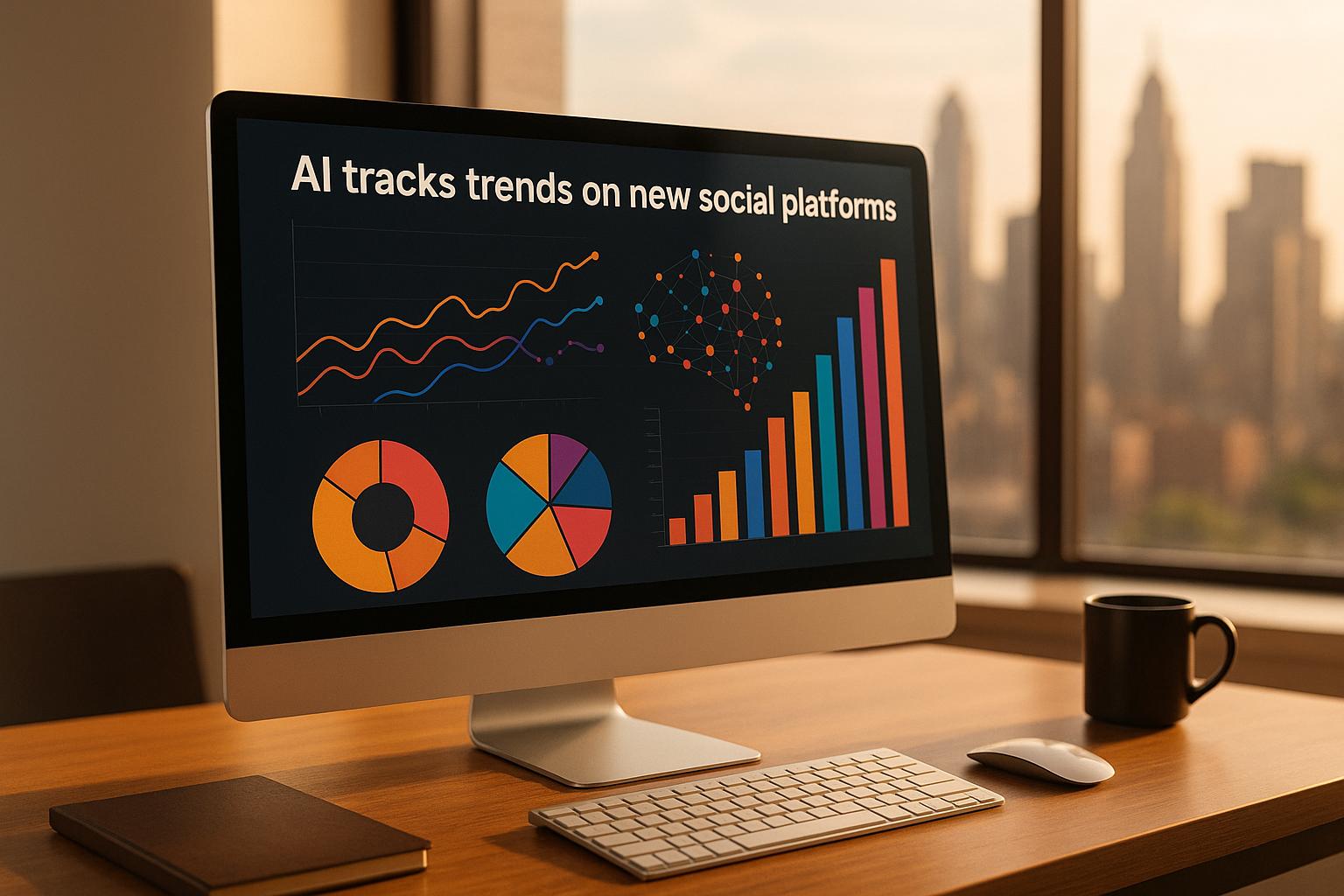Behavioral visualization makes threat detection faster, clearer, and more effective. It translates user and network activities into visual data, helping security teams spot unusual behavior - like a late-night login from an unfamiliar location - immediately. This modern approach addresses the weaknesses of older methods that rely on static rules and manual analysis.
Key Benefits:
- Real-Time Monitoring: Detect threats as they happen.
- Reduced False Positives: Focus on real risks, not noise.
- AI-Powered Insights: Identify patterns and anomalies automatically.
- Simplified Visual Tools: Use graphs, heatmaps, and timelines to understand complex data.
Core Features:
- Network Graphs: Map connections to spot unusual activity.
- Heatmaps: Highlight changes in user behavior over time.
- Time-Based Mapping: Track how attacks unfold step by step.
Why It Matters:
Traditional detection methods struggle with modern, evolving cyber threats. Behavioral visualization, combined with AI, provides faster detection, fewer false alarms, and even automated responses to contain risks immediately. These tools are essential for staying ahead of sophisticated attacks like insider threats and zero-day vulnerabilities.
Data visualization techniques for cyber security analysts
Main Features of Visualization Tools
Modern detection tools are fast and precise, but turning raw data into actionable insights requires effective visualization. Here’s how visualization tools bring clarity to complex security data.
Network Graphs for Spotting Patterns
Network graphs are like maps that chart connections between users, devices, and systems. These visual tools use nodes (points) and edges (lines) to uncover suspicious patterns. They make it easier to spot anomalies by including features like:
| Graph Feature | Security Use Case |
|---|---|
| Node clustering | Detects groups of related systems and unusual connections |
| Edge thickness | Indicates the volume of data transferred between points |
| Color coding | Flags risk levels and unusual behavior with visual cues |
This approach simplifies the process of identifying outliers in complex networks. But it’s not the only way to visualize user activity.
Heatmaps for User Behavior Analysis
Heatmaps take a different approach by focusing on user activity over time. They use color intensity to represent activity levels, making it easy to detect shifts in behavior. For example, if an employee who usually works during the day suddenly logs in at odd hours, the heatmap will highlight this unusual activity, helping security teams investigate further.
Mapping Attacks Over Time
Time-based mapping tools provide a chronological perspective on security events. By plotting activities on a timeline, these tools help teams understand how attacks unfold. This type of visualization is especially useful for:
- Tracking lateral movements within a system
- Pinpointing where an attack started and how it spread
- Connecting related events to see the bigger picture
When combined, these visualization techniques offer a detailed view of system activity, making it easier to detect threats quickly and respond effectively.
Setting Up Visualization Systems
Data Collection Setup
Before diving into visualization tools, it's crucial to establish a solid foundation for behavioral data collection. Start by taking stock of your IT systems to identify all potential data sources. Here’s a breakdown of key data types to monitor:
| Data Source Type | Required Information |
|---|---|
| Network Traffic | Authentication logs, access patterns, data transfer volumes |
| User Activity | Login times, application usage, resource access |
| System Events | Configuration changes, security alerts, process execution |
| Cloud Services | API calls, resource utilization, user interactions |
Ensure logging is configured with synchronized timestamps and secure transport protocols. This helps maintain data accuracy while keeping the impact on network performance minimal.
Tool Selection Guide
Choosing the right visualization tools means aligning their features with your security goals and infrastructure. Keep these factors in mind:
| Selection Criteria | Description |
|---|---|
| Integration Support | Compatibility with your existing security tools and data sources |
| Processing Speed | Real-time analysis for immediate threat detection |
| Compliance Features | Built-in controls to meet privacy regulations like GDPR or CCPA |
| Scalability | Ability to manage increasing data loads without slowing down |
| AI Capabilities | Machine learning tools for spotting patterns and detecting anomalies |
Staff Training Methods
A well-trained team is essential for effective visualization system use. Here's how to structure your training program:
- Foundation Training: Start with the basics. Teach your team the core principles of behavioral analytics and familiarize them with the tools. Make sure they understand what normal behavior looks like and how to identify anomalies in visual data.
- Hands-on Scenarios: Provide practical, real-world exercises. This helps analysts learn how to recognize patterns and interpret visual data effectively.
- Specialized Role Training: Create role-specific modules. For example, front-line analysts should focus on incident detection, while security leaders learn strategies for high-level response.
To keep skills sharp, schedule regular refreshers, mentorship opportunities, and practical assessments. Implement role-based access controls to ensure team members only see data relevant to their responsibilities. With this structured approach, your team will be ready to incorporate advanced AI features into your visualization systems.
sbb-itb-bec6a7e
AI Features in Visualization
AI takes visualization systems to the next level, making them sharper and more effective at detecting threats.
ML-Based Pattern Analysis
Machine learning (ML) algorithms are the backbone of advanced pattern recognition in behavioral visualization tools. These tools sift through massive amounts of behavioral data to establish normal patterns and spot anomalies. For example, ML can analyze historical data to flag subtle irregularities, like unusual login times or unexpected spikes in resource usage. This creates a strong foundation for AI to identify and connect more complex threat patterns.
AI Threat Pattern Detection
AI-driven visualization tools shine when it comes to uncovering intricate threat patterns across various data sources. They can automatically link events from multiple systems to expose coordinated attacks. Many modern platforms use techniques like temporal analysis to track time-based patterns, behavioral clustering to group related threat activities, and anomaly scoring to gauge the severity of potential risks.
Text Analysis for Context
AI also uses natural language processing (NLP) to add depth to threat analysis. By examining unstructured data - such as system logs, reports, and threat intelligence feeds - NLP provides critical context for alerts. This helps security teams better understand the scope and nature of potential threats, enabling faster and more informed responses.
Looking Ahead: Visualization in Security
Main Benefits
Behavioral visualization has come a long way, reshaping how businesses approach security threats. Modern tools now offer real-time threat detection and automated responses, making it possible to immediately alert IT teams about suspicious activities. These systems can even disconnect potential threats from the network automatically, which helps minimize damage.
According to Gartner, advanced behavioral detection analytics significantly strengthen security measures. These systems can detect subtle anomalies that traditional methods might miss - things like unusual login patterns or unexpected spikes in resource usage. It's no surprise that these analytics now surpass older approaches in uncovering sophisticated cyberattacks.
Here’s a quick look at the key benefits of behavioral visualization:
| Benefit | Impact |
|---|---|
| Real-time Detection | Swift identification of suspicious behavior |
| False Positive Reduction | Alerts are more accurate thanks to contextual analysis |
| Compliance Support | Automated reporting and audit trails simplify compliance |
| Insider Threat Prevention | Early identification of internal risks |
| Automated Response | Immediate containment of potential threats |
AI's Impact on Security Tools
These benefits pave the way for AI to take threat detection to the next level. With AI integration, behavioral visualization tools now go beyond reacting to threats - they can predict them. Machine learning algorithms analyze evolving data patterns, identifying new attack methods that traditional systems might overlook.
AI has also revolutionized how security teams investigate threats. Advanced visualization interfaces make complex data easier to interpret, allowing teams to quickly assess the scope and context of a threat. This leads to faster, more informed decision-making.
Looking ahead, some exciting developments in security visualization include:
- AI-driven hyper-automation for security responses
- Simplified interfaces to better understand complex threat patterns
- Enhanced predictive modeling, offering better foresight into potential risks
- Seamless integration with existing security systems
These innovations are particularly useful for businesses experiencing growth. By providing clear, actionable insights, behavioral visualization tools help organizations stay secure while navigating the challenges of scaling up their operations. For smaller businesses and startups, platforms like AI for Businesses can be a great starting point for exploring AI-powered security solutions.
FAQs
How does behavioral data visualization help reduce false positives in threat detection?
Behavioral data visualization brings clarity to user and system activity, helping to cut down on false positives. Traditional approaches often depend on rigid rules or fixed thresholds, which can miss the nuances in behavior. In contrast, visualization tools track patterns and anomalies over time, making it simpler to differentiate between everyday activity and real threats.
By transforming data into clear visuals, these tools empower security teams to quickly spot irregularities and zero in on actual risks. This not only streamlines their workflow but also boosts the precision of threat detection efforts.
How does AI enhance behavioral visualization tools for better threat detection?
AI has transformed behavioral visualization tools by enabling them to process massive datasets and spot unusual patterns or behaviors that could signal potential threats. Using machine learning algorithms, these tools can identify anomalies in real-time, offering quicker and more precise threat detection.
What’s more, AI-powered visualization simplifies decision-making by presenting clear, actionable insights through user-friendly dashboards. This allows businesses to strengthen their security measures and ensure compliance with industry regulations. By automating complex analyses, AI helps organizations stay ahead of emerging threats while streamlining their security operations.
How can businesses integrate behavioral visualization tools into their existing security systems effectively?
To bring behavioral visualization tools into your security framework, start by evaluating your current systems. Pinpoint areas where visualization can sharpen threat detection and enhance your defenses. Work closely with your IT and security teams to ensure the new tools will integrate smoothly with your existing setup.
When choosing a tool, look for features that match your business needs. Prioritize options that provide real-time data analysis, customizable dashboards, and AI-driven insights to help quickly identify unusual activity. Roll out the tool in phases to allow for thorough testing and necessary adjustments.
Don’t forget to train your team on how to use the system effectively. Regularly assess its performance and tweak configurations to address new and emerging threats. By doing this, you’ll not only boost your threat detection capabilities but also reinforce your overall security posture.


